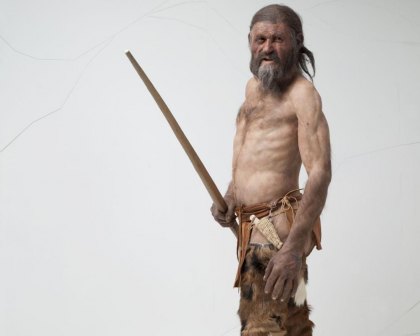Iceman's bacterium offers clues about migration

Depiction of Otzi, a 5,000-year-old mummy found in the Alps, (c) South Tyrol Museum of Archaeology/A. Ochsenreiter.
The answer is C, and this week, researchers announced that Otzi, a mummy discovered in the Alps in 1991, had a stomach bacterium that could help unravel clues about primitive migration.
The pathogen is helicobacter pylori, which is present in half of the world’s population. But fewer than 10 percent of carriers develop a related disease, manifested as stomach ulcers or gastric carcinoma, according to the journal Science.
“The pathogen not only accompanied modern humans out of Africa, but ... has also been associated with its host for at least 100,000 years,” according to the Science article by Frank Maixner, a microbiologist with the European Academy, and a team of researchers.
As a result, the bacterium is a marker used by scientists to trace demographic prehistoric events. The European H. pylori is a hybrid between Asian and African bacteria. But what scientists found in the iceman is a “nearly pure representative of the bacterial population of Asian origin that existed in Europe before hybridization, suggesting that the African population arrived in Europe within the past few thousand years,” the article said.
Otzi the iceman was discovered on Sept. 19, 1991. Two German hikers in the Otztal Alps in Northern Italy veered off the path and made a grisly discovery: a corpse, recounts the South Tyrol Museum of Archaeology in Italy. The hikers figured the man must have been the victim of a mountaineering accident. In the days that followed, attempts were made to retrieve the corpse. On Sept. 23, authorities managed to extract the mummy from the ice. Scientists subsequently determined that the man lived 5,000 years ago, between 3350 and 3100 BC.
A mummy, by Webster’s definition, is an “unusually well preserved” corpse. While this research has focused on Otzi’s biological makeup, his personal effects were also well preserved -- a copper-bladed axe, other tools and weapons and what is believed to have been a backpack. In 2001, the researchers used X-rays to conclude that the iceman was shot with an arrow and had been involved in hand-to-hand combat.
For more: See the South Tyrol Museum of Archaeology website and the research in Science.
Related:
In Brief: Murder among the ruins
If you would like to comment give us a shout or like us on Facebook and tell us what you think.

